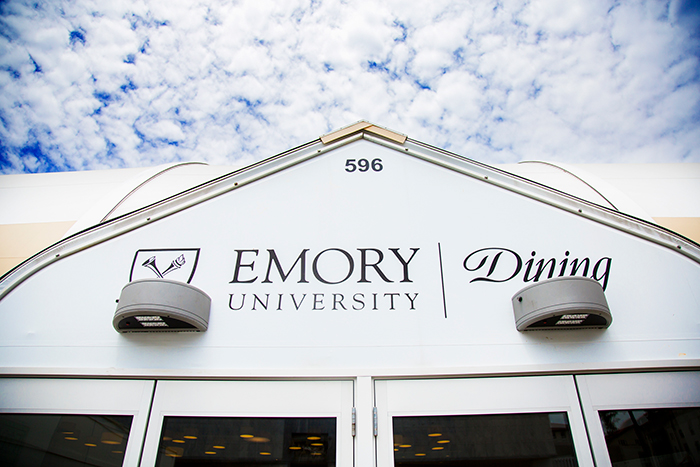Todd Doyle | July 18, 2018
Author’s note: This is a follow up to http://news.emory.edu/stories/2016/09/er_duc_interim_dining_facility/campus.html.

Opening in summer of 2017, the DUC-ling staff has served a year’s worth of meals to members of the Emory community. The interim dining hall project enters its second and final academic term with Emory, as construction of the CLC aims for completion in May 2019.
How did we get here, and where are we going?
Emory struck a deal with Harvard in 2017 to re-use their lighting fixtures, serving equipment, and other furnishings from their interim-dining hall during construction of a permanent dining facility. Harvard sent Emory their material materials for free; pending we donate the same materials to another interim dining hall project, or similar endeavor. David Furhman, Emory’s Finance, Administration & Operations Senior Director, says this type of structure is used by “colleges, universities, government installations all around the world, and the Olympics.” Repurposed panels will be assembled in a format based on the needs and geometry of the new location. Emory is currently in talks with Lehigh University to donate our food service equipment for their own DUC-ling-esque interim dining hall project.
While the most recent CLC building design is breathtaking, Emory students will miss the DUC-ling and the meme-worthy inflatable rubber duckling that spontaneously pops up outside the dining hall.
The structure from Harvard is not the only DUC-ling resource to be donated. “Tables and chairs may be repurposed, repainted and powder coated. But the plan right now is to donate them to an organization that will need or want them.” Furhman said. He added that “kitchen trailer units and their contents will be donated to Atlanta nonprofits in need of meal-serving equipment.” This includes all trays, as the CLC will be a tray-less facility as part of another sustainability effort. Students will be forced to think more critically about what is going on their plates, as the CLC will be a tray-less dining facility. This decision is rooted in sustainable thinking. “To add to that, not having to wash trays will save tens of thousands of gallons of water. We plan to quantify this once we go tray-less. Not only water is wasted, but electricity is needed to heat the water. Drying agents and detergents do not need to be purchased as much with only plates and silverware to wash. All of that goes away by going tray-less.” Furhman added. Data show that going tray-less saves money on food waste, as trays can encourage an artificial need to fill it up, and to take as much food as desired and then decide what to eat. Schools, missions, and soup kitchens need trays for meal programs.
Boston University reported a 25-30 percent decrease in food waste per person since a tray-less initiative was implemented in 2008. An ARAMARK study “The Business and Cultural Acceptance Case for Trayless Dining” estimates .33 to .5 gallons of water used per tray per wash, an enormous amount considering the number of trays washed daily.
Al Herzog, Program Manager of Planning, Design, and Construction, shed light on the future of the DUC-ling space. “Once the DUCling is removed the area will be prepped and landscape and hardscape improvements will be made so that it will complement the adjacent areas along this section of Asbury Circle.” This project unites colleges in their sustainability efforts as students all around the world eat in a sustainable structure.
